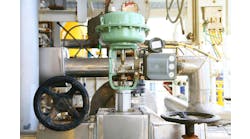Stan: It seems that people and organizations like the Hall of Fame concept. We’re no different. So, how about a Hall of Fame for really bad instruments, final control elements, and control systems? It would be appropriate to give the people and companies that thought of these things proper credit. However, we don’t have the slightest idea who or where most of them are now. We’ll nominate the first 10 candidates, and then it’s “Katy, bar the door!” Anyone and everyone can join in too. In no particular order, our nominees are:
- Foxboro used to build a control valve with a big handle on top of the spring and diaphragm actuator. The handle’s purpose was to adjust the spring range. The company that built a gas-fired, start-up furnace supplied one of these valves on the natural gas line. Some engineer felt it was his responsibility to turn the handle every time he walked by the valve. Use your imagination about what happened…
- Large-case pneumatic temperature controllers with 100 feet of capillary and proportional plus reset action. Actually, 50 or 25 feet of capillary didn’t do much better.
- The companies that had electronic instruments with signal ranges of 0–1 V, 0–5 V, 0–10 V, 0.4–2.0 mA, 10–50 mA…
- Control valves with advertised 3-15 psig and 6-30 psig spring ranges, though no one ever got one unless the valve trim was smaller than 3/8 in.
- Temperature transmitters that had filled elements with vaporizing liquids that produced a non-linear range.
- Glass-coated thermowells in the bottom of agitated reactor baffles.
- The guy who converted proportional band to gain, and inverted reset.
- Taylor Instruments’ Triscope pneumatic controllers that had rate before proportional band and reset. We purchased them, but don’t remember if they ever worked.
- Thermocouple and RTD pneumatic transmitters that came in a big, black, explosion-proof case that had vacuum tubes and an I/P transducer inside.
- Full-bore control valves that were supposed to imitate Fisher’s Vee Ball valve. They came with a positioner mounted on a cylinder actuation that was connected to the valve stem with a sloppy coupling.
Greg: To have room for our usual Top 10 list and some reader replies from Joel Cantrell and Scott Kelly to the December 2005 column, I will save my really bad nominations until the April 2006 issue.
Scott: Regarding the valve with four sets of trim in the December puzzler, at a 0.1 total Cv, this valve is obviously being used in an application requiring fairly high precision. Since the valve has virtually no turndown capacity, any error in the sizing parameters (DP, expected line loss) given for the valve specification will likely result in the valve being incapable of meeting the required flow capacity. Since it’s obviously a small valve, the trim cost is likely relatively inexpensive, so Stan is covering his bases in case the plant engineer gave him some faulty data.
Joel: At a low Cv, the valve either has a very high design DP, a very low expected flow, or both. Between capacity creep, energy optimization, and fouling, there is never as much DP available as the design condition suggests. The extra trim sets give the valve much greater range, if the expected operating condition should change from design. In addition, extra trim sets shouldn’t be tremendously expensive in this size range.
Scott: The problem with your December trend is that you have the reset set to 5 sec, and the "process" time constant is 50 sec. The controller is trying to make the process respond faster than it is capable of doing. You can "make" some processes respond faster than their natural time constant (temperature comes to mind), but these processes typically have large amounts of "integrating" capacity, and sticking large amounts of integral action onto a process with lots of integrating action of its own pretty much guarantees oscillation problems. Lambda tuning would have you set the reset to 50 sec (= to lag time), and adjust the proportional gain. To handle the effect of delay, some would say reduce the gain, while others would take the hit in reset time. If I needed to goose the response, for a process where it makes sense, I would try to do it with increased proportional action, not integral.
Greg: Living in Austin, I’ve learned to appreciate the spicier things in life. A song by the Red Hot Chili Peppers rock band brings to mind the insight of the month.
Insight: Nearly all processes have a margin set between the operating points and the equipment limitations or quality specifications to minimize problems with equipment operation and customer complaints. Reducing control system variability doesn’t pay off in terms of higher capacity or low raw material and energy costs until you move the operating points (set points). However, manufacturing is often reluctant to operate differently, even though the margin translates to product given away. For example, products are overreacted, purified and dried, sheets are over trimmed, and bags or drums are overfilled. Of course, the customer loves the free product. So, the next time you want to optimally make a point, sing the song’s lyric “Give it away! Give it away! Give it away!” as you enter the control room.
Groucho: Why, a four-year-old child could understand this. Someone get me a four-year-old child!
Greg: The following Top 10 list, like all my lists, was created while I was running. How long it takes depends on who is chasing me. The list includes contributions from Mark Sowell.
Top 10 Signs Your Job is Like a Reality TV Show
- Youth and inexperience triumphs over age and wisdom
- Playing the “game” is the key to survival
- The longer you are around the crankier you are and the less you care about your looks
- People behind the scenes are orchestrating predicaments
- A person disappears each day
- Your job life expectancy is less than a season
- The company’s goal is to get down to one person
- Everyone is scheming to be the lone survivor
- Only the executives really win
- The insanity of it all keeps you entertained
Greg: Creating concisely stated practical puzzlers is puzzling. Fortunately, Hunter Vegas has a wealth of field experience to keep us well supplied.
Hunter: The plant installed a magmeter on the water outlet of an ammonia vaporizer side-boiler to measure the water leaving the side-boiler. (The side-boiler vaporized the ammonia, and captured any water that was present in the ammonia. A level control measured the water/ammonia interface in the side-boiler, and let out water to maintain level.) One day the side-boiler level transmitter failed, and sent ammonia out the water outlet to the wastewater treatment area. The new flowmeter indicated zero ammonia flow, but the waste treatment area was complaining bitterly about the ammonia smell. What happened to the meter?
| About the Authors |




